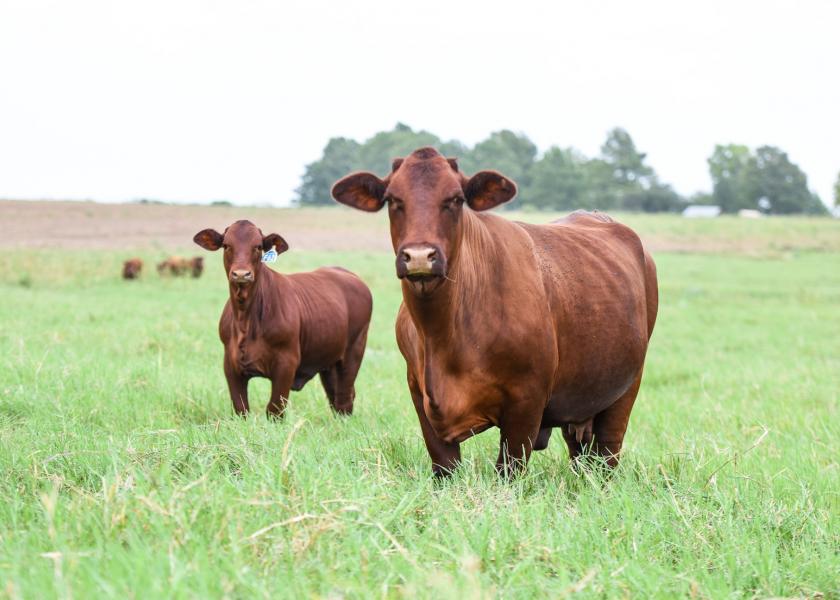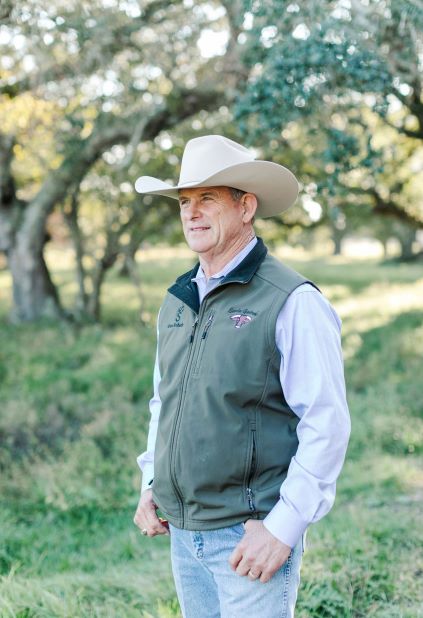For the Love of Red Cattle and Nancy

For Gene Kubecka, Bay City, Tex., incoming Santa Gertrudis Breeders International (SGBI) president, the Santa Gertrudis breed coincides directly with his relationship with his wife, Nancy, which started in 1970. At the time, there were no cell phones, just party lines, so when you were interested in somebody, you had to get involved in an activity together to get to know them better. Though the two met through 4-H, Kubecka says he knew that if he was going to be with Nancy, he had to take a liking to the red cattle that her family was raising.
Kubecka had come from a farming and commercial cattle operation, but his first experience with purebred cattle was a Santa Gertrudis steer he purchased from Nancy’s family, which he won the showmanship class at the local county fair with. It was a couple years later, after a Santa Gertrudis steer he raised won a purebred steer show that Nancy or her sister usually won, that Kubecka says he finally got his foot in the door with his future wife. The rest is history.
After their wedding in 1978, the couple started their own Santa Gertrudis herd. Their children, Daniel and Jenna, who represent the fourth generation of Santa Gertrudis breeders, followed suit in raising and promoting the breed. Gene and Nancy with Daniel and his wife, Lauren, eventually purchased Nancy’s parents’ herd, forming Wendt Ranches Partners, LLC. The fifth generation of Kubeckas are raising and showing Santa Gertrudis cattle as well.

Though the breed did help his young love interest, Kubecka says it became clear early on that Santa Gertrudis cattle had a special place in his future. They appealed to him because of their true American origins, their ability to adapt to many different climate areas and their ability to cross well with both American and European cattle.
The breed has adapted and evolved in the past 50 years that Kubecka has been involved, including downsizing the overall size of the breed to become more efficient, cleaning up underlines and udders, improving soundness and overall quality, and breeding for more docile dispositions. The value of the breed’s hybrid vigor has stayed the same.
“The heterosis derived from these crosses is second to none,” Kubecka says. “These red cattle can grow hair in colder climates or maintain short hair in warmer climates and remain productive and be profitable.”
Thanks to the internet and online meetings, Kubecka sees more opportunities for the association’s committees to be more active and productive than ever before. He has worked on a number of committees within the association to improve the cattle’s standings, not only in the breed but in the cattle industry as a whole, almost since his first involvement with the breed 50 years ago. He was a founding member of the Mid-Coast Junior Association and served in various capacities with the Mid-Coast Super Sale. He served as co-chairman of two National Santa Gertrudis Junior Heifer Shows, chairman of Santa Gertrudis Breeders International Foreign Marketing Committee, chaired the SGBI Performance Committee for six years, became SGBI vice president of Marketing and Promotion and served two stints on the SGBI Board of Directors.
His time spent serving the association and its members, combined with his experience as a producer, gives Kubecka a clear idea of where he would like to see the association move in the future and, specifically, in ways that will help the breed gain popularity in the commercial cattle industry.
“I’m very adamant that if we want to be a viable breed and association, we must whole-herd report,” he says. “In order for our breed to maintain its relevancy in the beef industry, we have to know what our genetics are doing, what they are capable of doing, and we have to get that into the commercial industry. We can sell cattle among ourselves, but we’ve got to expand what our cattle can do in the commercial industry.”
Crossbreeding is where commercial Santa Gertrudis cattle shine, and Kubecka hopes the breed can move forward, without discrimination, toward the American Red and the Super American crosses.
“I think there’s room for both,” he says. “Let’s make our cattle more relevant to the commercial industry, and if that takes crossbreeding, let’s do that because the industry as a whole is changing so much.”
Another way Kubecka hopes to help the breed be more visible to commercial cattlemen is by making sure the breed chooses the best genomic platform moving forward, something he anticipates being a big topic at the upcoming annual meeting.
“We need to be comparing our genetics to competing breeds out there, and there are some genetic platforms that allow us to do that more than others, giving us a larger footprint in the commercial cattle industry,” Kubecka says. “For us to know what our genetics are capable of doing, we have to continue to track our cattle all the way from birth to the rail. We’ve got to scan our cattle and know what our cattle genetically bring to the table and what they can pass on, or what a commercial operator will gain by using Santa Gertrudis genetics.”
Numbers speak volumes, and Kubecka knows the breed will stand out as long as numbers are recorded and compared to further enhance the breed's genetics.
“Sure, I like to sell genetics to other Santa Gertrudis breeders, but we have to sell our genetics to the commercial industry, too. So why not see where we stand against our competing breeds, because our competition shouldn’t be other Santa Gertrudis breeders, it should be other breeds of cattle,” Kubecka says. “We’re one big family. We may have different ideas, but at the end of the day, we all come together.”
During his time as president, Kubecka hopes to encourage the SGBI Board to stay focused on serving the membership and helping them to have more profitable cattle operations. He hopes he can encourage members to take advantage of all the performance-enhancing opportunities that the association offers.
“It’s imperative as a purebred association that our purebred genetics continue to be the foundation of our breed and we do not lose sight of its importance,” Kubecka says. “My goal is to be a very visible president, participating in as many breeder activities as possible and to be a familiar face to the beef cattle industry and its activities.”







